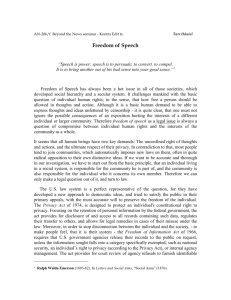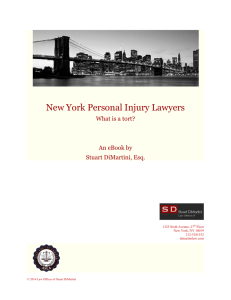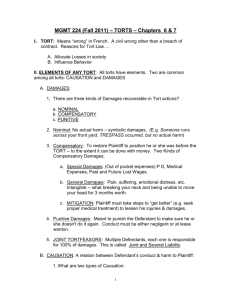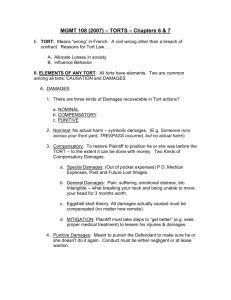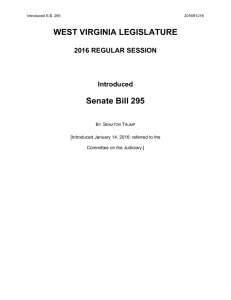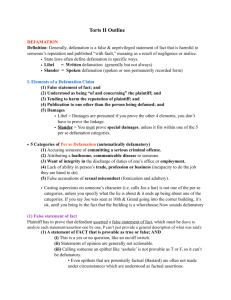Torts: Legal Wrongs and the Rule of Law
advertisement
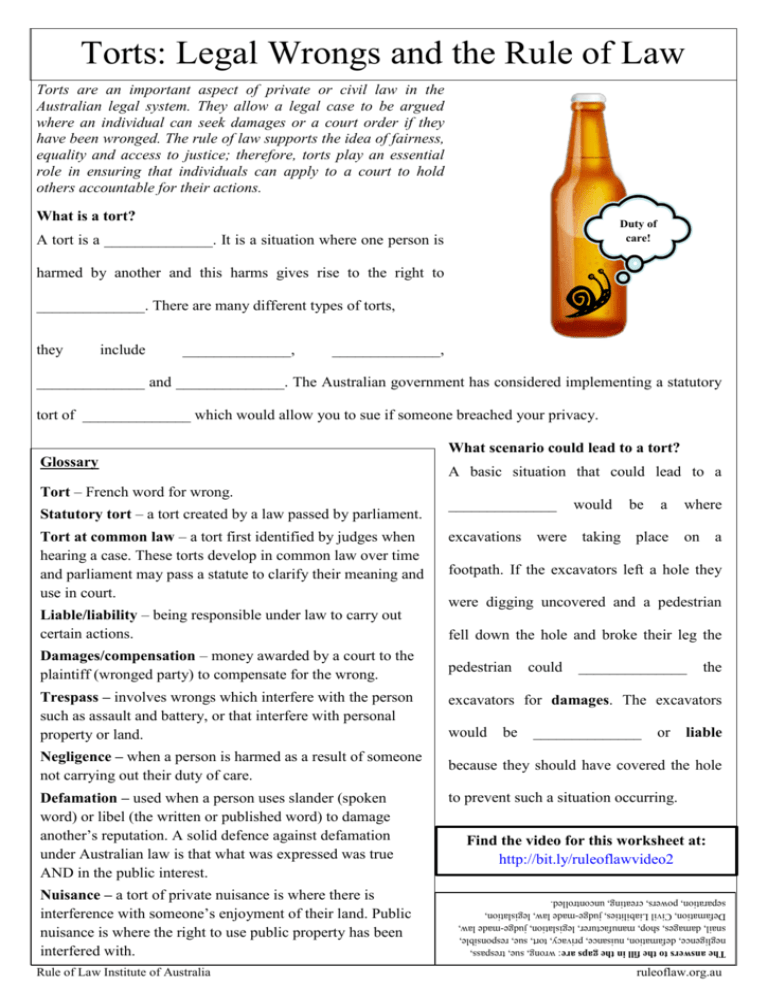
Torts: Legal Wrongs and the Rule of Law Torts are an important aspect of private or civil law in the Australian legal system. They allow a legal case to be argued where an individual can seek damages or a court order if they have been wronged. The rule of law supports the idea of fairness, equality and access to justice; therefore, torts play an essential role in ensuring that individuals can apply to a court to hold others accountable for their actions. What is a tort? Duty of care! A tort is a ______________. It is a situation where one person is harmed by another and this harms gives rise to the right to ______________. There are many different types of torts, they include ______________, ______________, ______________ and ______________. The Australian government has considered implementing a statutory tort of ______________ which would allow you to sue if someone breached your privacy. What scenario could lead to a tort? Tort – French word for wrong. Statutory tort – a tort created by a law passed by parliament. Tort at common law – a tort first identified by judges when hearing a case. These torts develop in common law over time and parliament may pass a statute to clarify their meaning and use in court. Liable/liability – being responsible under law to carry out certain actions. Damages/compensation – money awarded by a court to the plaintiff (wronged party) to compensate for the wrong. Trespass – involves wrongs which interfere with the person such as assault and battery, or that interfere with personal property or land. Negligence – when a person is harmed as a result of someone not carrying out their duty of care. Defamation – used when a person uses slander (spoken word) or libel (the written or published word) to damage another’s reputation. A solid defence against defamation under Australian law is that what was expressed was true AND in the public interest. Nuisance – a tort of private nuisance is where there is interference with someone’s enjoyment of their land. Public nuisance is where the right to use public property has been interfered with. Rule of Law Institute of Australia A basic situation that could lead to a ______________ would be a where excavations were taking place on a footpath. If the excavators left a hole they were digging uncovered and a pedestrian fell down the hole and broke their leg the pedestrian could ______________ the excavators for damages. The excavators would be ______________ or liable because they should have covered the hole to prevent such a situation occurring. Find the video for this worksheet at: http://bit.ly/ruleoflawvideo2 The answers to the fill in the gaps are: wrong, sue, trespass, negligence, defamation, nuisance, privacy, tort, sue, responsible, snail, damages, shop, manufacturer, legislation, judge-made law, Defamation, Civil Liabilities, judge-made law, legislation, separation, powers, creating, uncontrolled. Glossary ruleoflaw.org.au Are there any famous tort cases? The most famous tort case is Donoghue v Stevenson [1932] UKHL 100. A woman ordered ice cream from a café. When she was pouring the ginger beer onto the ice cream a ______________ fell from the bottle. She was quite distressed and wanted to seek ______________ from someone. She could not seek damages from the ______________ because they had not done anything wrong. Donoghue wanted to go further and seek damages from the ______________ of the ginger beer because they should have ensured there were no impurities in the bottle. She was successful and won the case, which was eventually settled out of court for the sum of £200. This is about £9800 in the United Kingdom today or $15200 AUD on 18-06-12 assuming 1 AUD = 0.64 GBP). How is tort law developed? Tort law is developed by a combination of ______________ and ______________. Some legislation judges must apply in tort law are the ____________________ Act 2005 (Qld) and the ____________________________ Act 2003 (Qld). When applying this law the judge may need to interpret the legislation and make a finding on something not written in the legislation – this is referred to as ____________________________ or common law. Judge-made law (common law) and ______________ is what extends and develops tort law. What is the relationship between tort law and the rule of law? Any possible conflicts? The rule of law supports the ______________ of ______________ which could be seen to be in conflict with judge made tort law. This is because when judges make law they are ______________ rather than applying it, however, judge made law only creates slow incremental changes. The rule of law requires that there is no ______________ use of power; therefore judge-made tort law is well within the rule of law. Glossary Separation of powers – a requirement in the Australian Constitution that ensures the powers of government are defined and that they do not overlap. This allows for a system of checks and balances to operate between the three arms of government: the legislature, executive and the judiciary. Civil Liability Act 2003 (Qld) – contains laws for Queensland relating to claims for damages as a result of death or personal injury caused by a person. Defamation Act 2005 (Qld) – contains laws which define defamation and provide guidelines for courts on how to deal with defamation cases. Example: s25-33 outlines defences against defamation. Rule of law – that all people are equal before the law and that the legal system has a set of checks and balances in place to ensure power is exercised according to the law, not outside of it. Rule of Law Institute of Australia ruleoflaw.org.au Proving Negligence in a Civil Case A plaintiff must show the court that: 1. the defendant had a duty of care 2. the duty of care was breached 3. the breach caused the harm The plaintiff holds the burden of proof and must prove the defendant has been negligent on the balance of probabilities in a civil case. How important is the snail in terms of negligence? Donoghue v Stevenson is a well-known for raising two principles of law in relation to negligence: The Neighbour principle – that a person has a duty of care to avoid actions or omissions where harm is reasonably foreseeable. Anyone who can be affected by your actions is considered a neighbour. Donoghue was unable to claim damages under contract law as her friend bought the drink for her. This meant there was no contractual relationship between her and the shop or manufacturer. Duty of care established liability without the need for a contract. Products liability principle – suggested that manufacturers can be held responsible for damage their products caused without a contractual relationship with the user. While Donoghue v Stevenson [1932] is a famous case which Glossary outlined these principles, Australia has long since developed its Plaintiff or complainant - the person own legislation and common law relating to negligence and bringing the complaint against the defendant duty of care in a variety of situations. This law is spread across in a civil proceeding. numerous acts, some are: Burden of proof – the plaintiff in civil cases holds the burden of proof. Though in certain circumstances this can be reversed. Defendant or respondent – the person being sued by the plaintiff who defends themself against charges. Standard of proof – the level of certainty required by the court to defendant guilty or liable for damages. On the balance of probabilities – the standard of proof in most civil cases. The plaintiff must establish that what they say happened is more likely than not. Duty of care – that a person must avoid actions or omissions where harm is reasonably foreseeable. Omission – failure to act when required. Reasonably foreseeable – that a reasonable person could predict the result of an action or omission. Rule of Law Institute of Australia - Australian Consumer Act 2010 (Cth) Civil Liability Act 2003 (Qld) Activity 1. Divide your page into three sections with the following headings: proof of duty, proof of breach, breach caused harm. 2. Create your own negligence case and describe the evidence you would offer the court under each heading. 3. Present the case to your class and teacher. They can be the judge and jury! Further Reading The Justice Education Society of Canada has a movie about Donoghue v Stevenson on their website: http://www.justiceeducation.ca/resources/Paisley-Snail - the movie is long, see 8:00, 21:00, and 27:00 for some perspectives on the case and its influence. The Supreme Court of Queensland provides a summary of the judgement from the UK House of Lords along with discussion questions and answers: http://www.sclqld.org.au/infofor/schools/case_quiz/pdf/snail.pdf ruleoflaw.org.au A snail in our times? Ronald Ball v PepsiCo [2011] Read the facts of the case and the Haiku on Mountain Dew and answer the following questions. 1. 2. 3. 4. 5. Who is the defendant in this case? Who is the plaintiff in this case? What is the alleged breach of the duty of care? Outline how the case has progressed. What does the haiku mean when it says ‘to do the Dew, or to not do the Dew’? Facts of the Case Ronald Ball v PepsiCo, Madison Co., Wisconsin. 2011, 09-L-440 (United States) Ball filed papers in the Madison County court alleging PepsiCo had been negligent seeking damages of $75000 USD and costs. He has alleged that PepsiCo has breached its duty of care by allowing a mouse to contaminate a can bought from the vending machine at his work. After taking a sip of the drink, Ball spat it out and became violently ill. The contents of the can were then poured into a cup where a dead mouse was found. PepsiCo has moved to have the case dismissed after a veterinary pathologist who examined the mouse, sent in by Ball, concluded that it was impossible for the mouse’s body to have survived in the drink as it would have turned it into a jelly like substance. Madison County Circuit Judge Dennis Ruth adjourned the proceedings in November 2011 allowing Ball to amend his complaint and for PepsiCo to respond. In April 2012 PepsiCo filed its response. The case is ongoing as of 25/07/2012. Further Reading A Haiku on Mountain Dew Wisconsin man sues Mountain Dew. Claims his bottle Contained a mouse. Eek! Defendant moves for Dismissal. The grounds? The claim Is impossible. Mountain Dew would have Turned the whole mouse into a “jelly-like substance.” For a list of the links below see: http://bit.ly/LavvTP Wall Street Journal Blog interviewing the plaintiff’s solicitor: http://blogs.wsj.com/law/2012/01/09/law-blog-fireside-the-personalinjury-lawyer-in-the-mountain-dew-mouse-case/ Sydney Morning Herald article on the case with some comments about Australian consumer law: http://www.smh.com.au/opinion/legal-eaglesdrink-to-a-mouse-a-snail-and-a-can-of-worms-20120111-1pvei.html Madison County Court documents on the case: http://www.scribd.com/full/77689744?access_key=key2d0qvlv5vgglyweduhfw The Madison Record newspaper report of the case: http://www.madisonrecord.com/news/240607-pepsico-granted-moretime-to-plead-in-mouse-in-mountain-dew-case Rule of Law Institute of Australia Wait, you’re kidding right? This cure, worse than the disease! Marketing? PR? To do the Dew, or To not do the Dew, Shakespeare, That is the question. By Steven Buckingham Attorney at Gallivan, White & Boyd, P.A. Reproduced with permission from the Abnormal Use: An Unreasonably Dangerous Products Blog: http://abnormaluse.com/2012/01/a-haiku-onmountain-dew.html pun – a language device which makes humourous use of a word to emphasise different meanings, somewhat like Dew and ______________ of ______________. ruleoflaw.org.au Further Reading on Ball v PepsiCo http://www.legalnewsline.com/news/235821-default-judgment-withdrawn-in-mouse-in-mt.-dew-case http://www.scribd.com/full/77689744?access_key=key-2d0qvlv5vgglyweduhfw http://www.madisonrecord.com/news/240607-pepsico-granted-more-time-to-plead-in-mouse-in-mountaindew-case http://www.madisonrecord.com/news/240713-mouse-in-mountain-dew-case-goes-viral http://abnormaluse.com/2012/01/a-haiku-on-mountain-dew.html http://www.smh.com.au/opinion/legal-eagles-drink-to-a-mouse-a-snail-and-a-can-of-worms-201201111pvei.html Rule of Law Institute of Australia ruleoflaw.org.au




